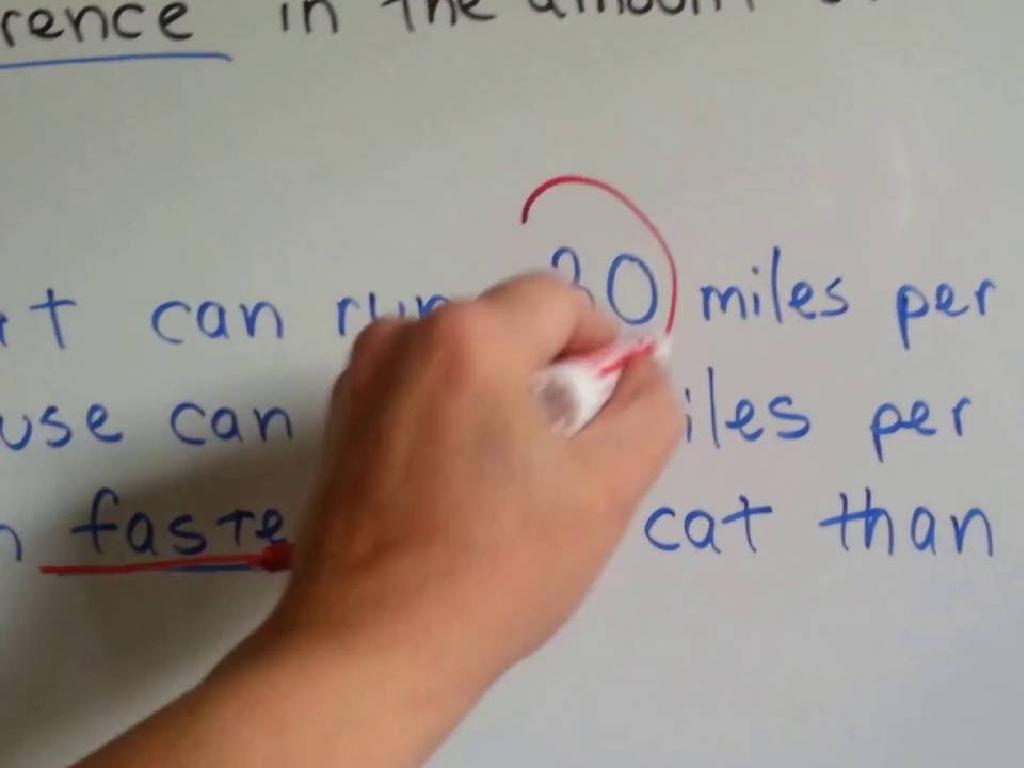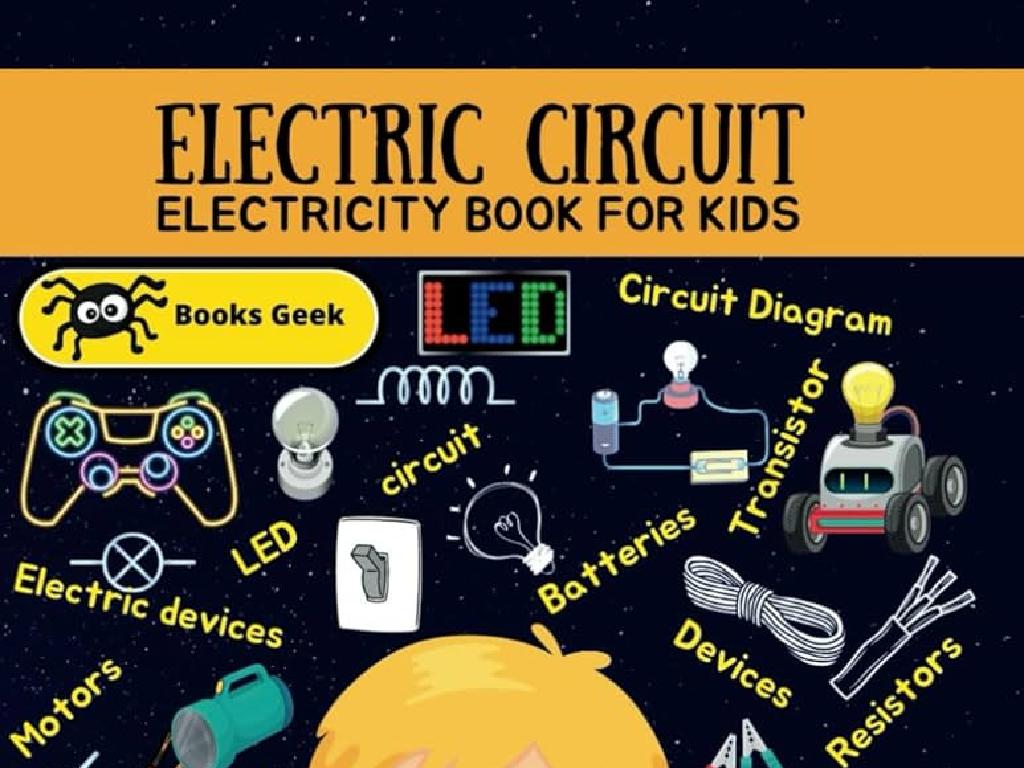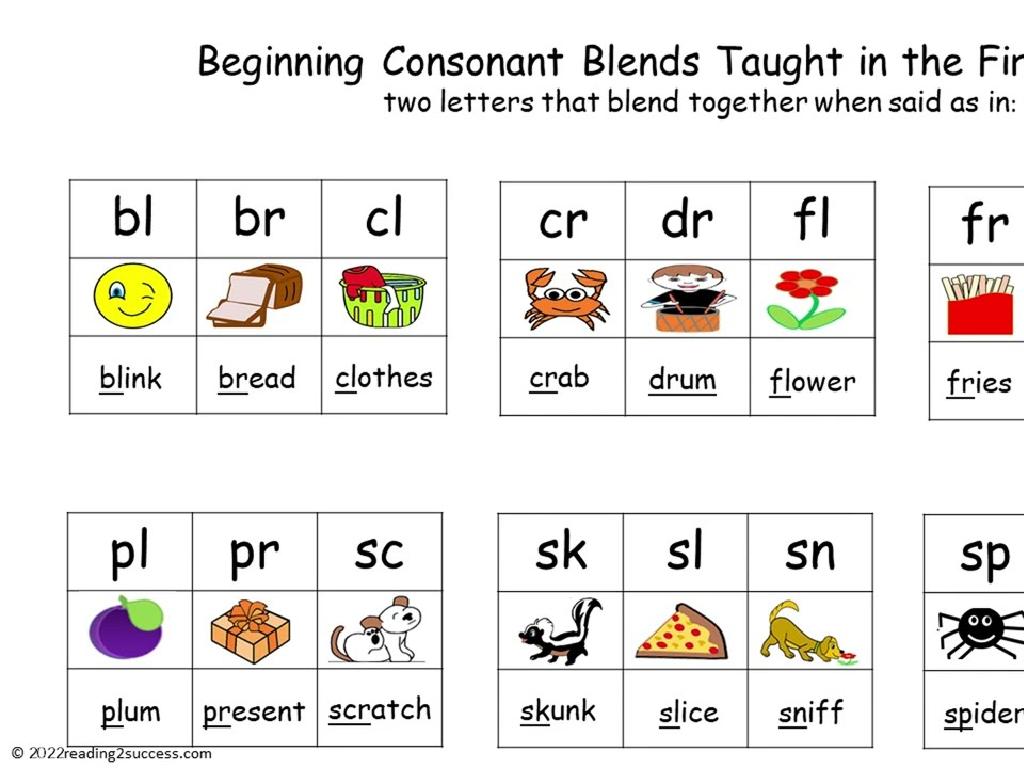Count Lines Of Symmetry
Subject: Math
Grade: Fourth grade
Topic: Symmetry
Please LOG IN to download the presentation. Access is available to registered users only.
View More Content
Exploring Symmetry in Our World
– Understanding symmetry
– Symmetry is when two halves of a whole mirror each other.
– The importance of symmetry
– Symmetry creates balance and is found in art, nature, and architecture.
– Finding symmetry in daily life
– Look for symmetry in butterflies, leaves, or even your own face!
– Recognizing symmetrical shapes
– Shapes like squares and circles have multiple lines of symmetry.
|
This slide introduces the concept of symmetry, which is a fundamental part of geometry. Symmetry refers to a balance or pattern where one side of an object or design mirrors the other. It’s important for students to recognize symmetry as it appears in various aspects of life, from art to nature, and to understand its role in design and aesthetics. Encourage students to observe their surroundings and identify symmetrical objects. Provide examples such as a butterfly’s wings or a snowflake. Discuss how shapes like squares, rectangles, and circles have lines of symmetry that divide them into equal parts. This will set the stage for learning how to count lines of symmetry in different shapes.
Understanding Lines of Symmetry
– What is a Line of Symmetry?
– It’s an imaginary line where you can fold an image and have both halves match exactly.
– Identifying Lines of Symmetry
– Look for the line where two sides are mirror images.
– Comparing Symmetrical vs Asymmetrical
– Symmetrical objects are identical on both sides of the line, while asymmetrical objects are not.
– Practice with shapes
|
Begin by explaining the concept of symmetry, focusing on the Line of Symmetry as a fundamental element. Use simple, everyday objects as examples to illustrate symmetrical and asymmetrical objects. Encourage students to visualize folding shapes along lines of symmetry to understand the concept better. Provide various shapes for students to practice on, identifying whether they are symmetrical or asymmetrical and drawing lines of symmetry where applicable. This will help solidify their understanding through visual learning and hands-on practice.
Lines of Symmetry in Shapes
– Symmetry in squares
– A square has 4 lines of symmetry
– Symmetry in rectangles
– A rectangle has 2 lines of symmetry
– Symmetry in circles
– A circle has infinite lines of symmetry
|
This slide is aimed at helping fourth-grade students understand the concept of symmetry in different shapes. Begin by explaining that a line of symmetry is where a shape can be folded over and both sides match perfectly. Show that a square has four lines of symmetry, which means it can be folded in four different ways to show equal halves. Then, demonstrate that a rectangle has two lines of symmetry, dividing it into equal parts along the length and the width. Lastly, explain that a circle is unique because it can be folded along an infinite number of lines that pass through the center, and each fold will show two equal halves. Encourage students to draw these shapes and fold them to visually see the lines of symmetry. This hands-on activity will help solidify their understanding of symmetry in geometric shapes.
Finding Symmetry in Letters
– Explore alphabet symmetry
– Which letters look the same on both sides?
– Types of symmetry in letters
– Vertical cuts the letter into mirror halves. Horizontal and diagonal do the same in their directions.
– Activity: Find symmetrical letters
– Look at each letter and test for symmetry
– Share your findings with the class
|
This slide introduces students to the concept of symmetry through the familiar context of the alphabet. Begin by asking students which letters they think are symmetrical and why. Discuss the three types of symmetry: vertical, horizontal, and diagonal, and provide examples of each using letters from the alphabet. For the activity, have students draw lines of symmetry on paper or use manipulatives to test each letter. Encourage them to explain their reasoning for each letter’s symmetry or lack thereof. After the activity, students should be ready to present their findings and discuss as a class. This will help reinforce their understanding of symmetry and how it can be found in everyday objects and text.
Symmetry in Nature
– Nature’s symmetry examples
– Look at patterns in animals, plants, and more
– Butterfly symmetry lines
– Butterflies typically have 1 line of symmetry
– Symmetry in leaves
– Not all leaves are symmetrical, let’s find ones that are
– Symmetry in flowers
– Many flowers have multiple symmetry lines
|
This slide aims to show students that symmetry is not just a mathematical concept but is also prevalent in nature. Start by discussing symmetry in general and then provide examples from nature, such as the patterns on animals and the shapes of plants. Explain that butterflies are a classic example of symmetry, with most having just one line of symmetry down the center of their bodies. Move on to leaves and flowers, encouraging students to look for lines of symmetry in the natural world around them. Some leaves will have one central line of symmetry, while others may not be symmetrical at all. Flowers often have multiple lines of symmetry, which can be a fun discovery activity. The goal is to help students recognize symmetry in their environment and understand its properties.
Practice Time: Exploring Symmetry
– Draw shapes to find symmetry
– Group activity: symmetrical art
– Work together to create art with one or more lines of symmetry
– Share your symmetrical creations
– Present your artwork to the class and explain the symmetry
– Discuss symmetry discoveries
– Talk about the different lines of symmetry found in various shapes
|
This slide is designed for a hands-on group activity where students will draw shapes and create art to explore the concept of symmetry. Provide students with paper, rulers, and drawing tools. Divide the class into small groups and instruct them to draw shapes, then fold them to find the lines of symmetry. Next, each group will create a piece of art that is symmetrical, using their knowledge of symmetry lines. After the activity, students will share their symmetrical art with the class, explaining where the lines of symmetry are. Encourage discussion about how many lines of symmetry different shapes have and why. This activity will help solidify their understanding of symmetry in a fun, interactive way. Prepare to offer guidance and ensure each student participates in both the creation and presentation stages of the activity.
Class Activity: Symmetry Hunt
– Find symmetrical classroom objects
– Draw objects and symmetry lines
– Include all lines of symmetry you find
– Present your symmetrical object
– Discuss symmetry with classmates
– Share what makes your object symmetrical
|
This activity is designed to help students recognize and understand symmetry in everyday objects. Encourage students to look around the classroom for items that have lines of symmetry, such as a book, a desk, or a pair of scissors. They should draw these objects and indicate the lines of symmetry with a ruler or straight edge. After drawing, students will present their findings to the class, explaining how they determined the lines of symmetry. As a teacher, prepare to guide them through the process, ensuring they understand that a line of symmetry divides an object into two identical parts. Provide assistance in drawing straight lines and offer praise for effort and participation. Possible variations of the activity could include finding symmetrical objects in magazines, creating symmetrical artwork with paint, or using symmetry in designing a simple ‘kaleidoscope’ pattern.
Symmetry Wrap-Up and Looking Ahead
– Recap lines of symmetry
– A line of symmetry divides a shape into mirrored halves.
– Importance of symmetry
– Symmetry is found in art, nature, and design.
– Introduction to asymmetry
– Asymmetry means no lines of symmetry; it’s the opposite of symmetry.
– What to expect next class
|
As we conclude today’s lesson on symmetry, remind students of the key concept of lines of symmetry, which split a shape into two identical parts. Emphasize the prevalence of symmetry in their daily lives, such as in architecture, art, and even in the natural world, which can help them appreciate the concept’s relevance. Introduce asymmetry as the next topic, explaining that it represents a lack of symmetry, providing a contrast that they will explore in the upcoming class. Encourage students to observe objects around them to see if they can identify symmetrical and asymmetrical shapes to prepare for the next lesson.






